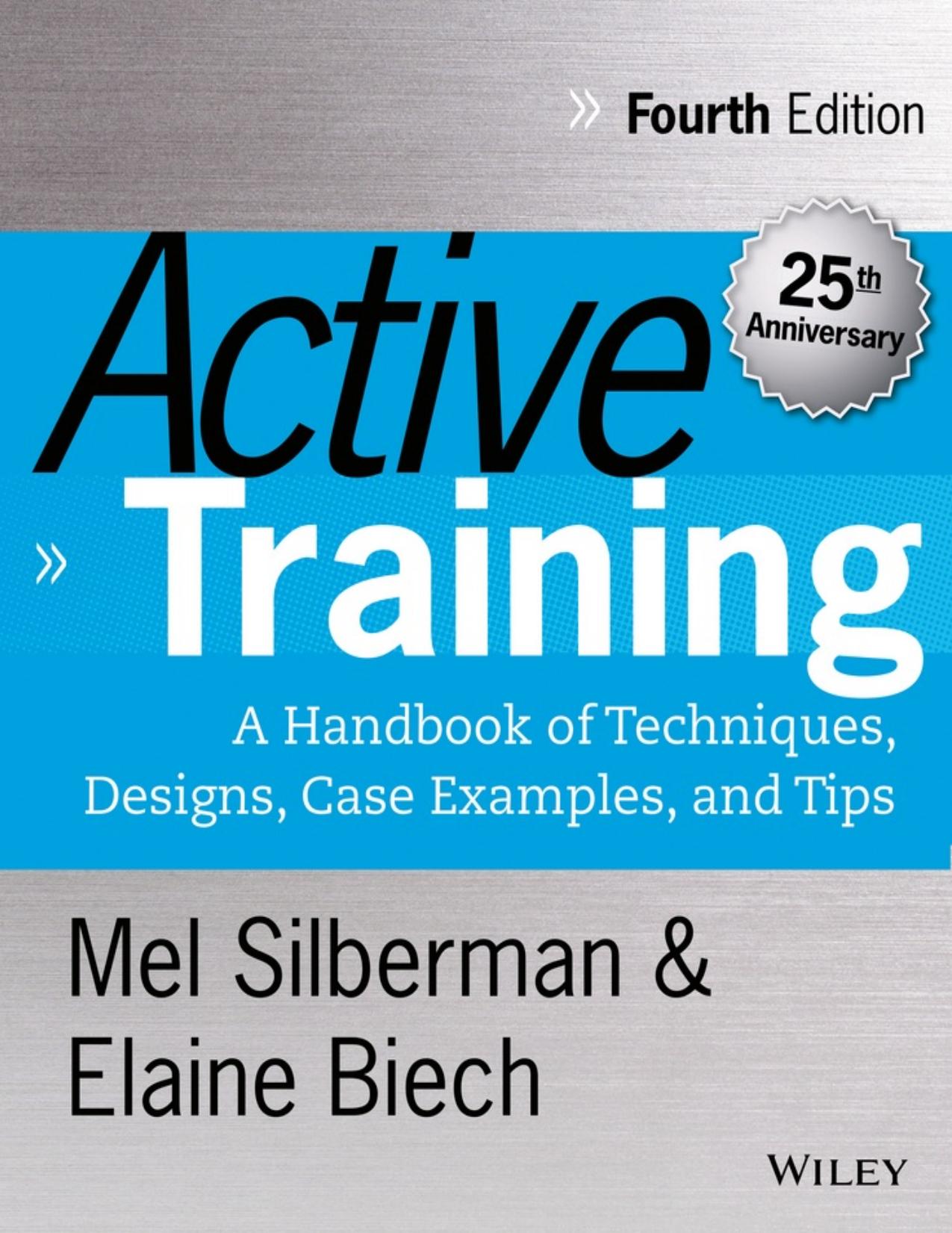Active Training A Handbook of Techniques Designs Case Examples and Tips 4th Edition by Melvin, Elaine 9781118972038 1118972031
$70.00 Original price was: $70.00.$35.00Current price is: $35.00.
Instant download Active Training A Handbook of Techniques Designs Case Examples and Tips 4th Edition 1118972015 after payment
Active Training A Handbook of Techniques Designs Case Examples and Tips 4th Edition by Melvin L. Silberman, Elaine Biech – Ebook PDF Instant Download/Delivery: 9781118972038, 1118972031
Full dowload Active Training A Handbook of Techniques Designs Case Examples and Tips 4th Edition after payment

Product details:
• ISBN 10:1118972031
• ISBN 13:9781118972038
• Author:Melvin L. Silberman, Elaine Biech
Active Training: A Handbook of Techniques, Designs, Case Examples and Tips
Active Training A Handbook of Techniques Designs Case Examples and Tips 4th Table of contents:
How Can Information Be Collected?
Part I
Part II
What If There Is No Time to Do a Proper Assessment?
Chapter Two Developing Active Training Objectives
Setting Learning Goals
Selecting Objectives
Specifying Objectives
Expressing Objectives
Communicating Training Objectives to Others
Developing Active Training Objectives
Chapter Three Creating Opening Exercises
What Opening Exercises Accomplish
What to Keep in Mind When Creating Opening Exercises
Ten Ways to Open an Active Online Virtual Training Session
Ten Ways to Obtain Participation
Chapter Four Preparing Brain-Friendly Presentations
Five Ways to Gain Your Audience’s Interest
Five Ways to Maximize Understanding and Retention
Five Ways to Involve Participants During a Presentation
Five Ways to Reinforce Presentations
An Example of a Well-Designed Presentation
Preparing Brain-Friendly Presentations
Chapter Five Finding Alternative Methods to Presenting
Demonstration
Case Study
Guided Teaching
Group Inquiry
Information Search
Study Group
Jigsaw Learning
Learning Tournament
Applying the Alternatives to a Common Topic
Finding Alternative Methods to Presenting
Chapter Six Using Experiential Learning Approaches
Role Playing
Games and Simulations
Observation
Mental Imagery
Writing Tasks
Instructions:
Technical
Performance
Your Preplanned Questions
Technical
Performance
Action Learning
Background
Current Status
Planning Chart
Using Experiential Learning Approaches
Strategy Outline:
Chapter Seven Designing Active Training Activities
The Three Major Ingredients of Any Design
Old Contract
New Contract
Basic Questions About Any Design
The Remaining Details
Three Tips for Creative Designs
Designing a Training Activity
Chapter Eight Sequencing Active Training Activities
Basic Sequencing Guidelines
Applying Sequencing Guidelines
The Finer Side of Sequencing
Experiential Learning Sequences
Procedure
Sequencing Active Training Activities
Chapter Nine Planning Active Training Programs
The Macrodesign of an Active Training Program
Planning an Active Training Program
Chapter Ten Incorporating Active Learning in All Training
Asynchronous E-Learning
Group-Based E-Learning
Virtual Classrooms
Blended Learning
Social Media Expands Active Training and Development
M-Learning Offers Instant Options
Blending in Technology
Part Three Conducting an Active Training Program
Chapter Eleven Beginning an Active Training Program
Preparing Yourself Mentally
Arranging the Physical Environment
Greeting Participants and Establishing Rapport
Getting the Best from the First Thirty Minutes of Training
Reviewing the Agenda
Inviting Feedback to the Agenda
Beginning an Active Training Program
Chapter Twelve Gaining Leadership of the Group
Setting Group Norms
Controlling Timing and Pacing
Increasing Receptivity to Your Leadership
Handling Problem Situations
Gaining Leadership of the Training Group
Chapter Thirteen Giving Presentations and Leading Discussions
Knowing Your Group
Organizing Your Presentation
Watching Your Body Language
Adding Visuals
Making Smooth Transitions
Facilitating a Lively Discussion
Giving Presentations and Leading Discussions
Chapter Fourteen Facilitating Structured Activities and Promoting Team~Learning
Structured Activities
Team Learning
Facilitating Structured Activities
Promoting team Learning
Chapter Fifteen Concluding an Active Training Program
Reviewing Program Content
Obtaining Final Questions and Concerns
Promoting Self-Assessment
Focusing on Back-on-the-Job Application
Expressing Final Sentiments
Concluding an Active Training Program
Part Four Extending the Value of An Active Training Program
Chapter Sixteen Providing for Back-on-the-Job Application
Prior to the Training Program
During the Training Program
At the End of the Training Program
Obstacle Assessment
Peer Consultation
Self-Monitoring
To understand people better:
To express myself more clearly:
To assert my needs better:
To exchange feedback better:
To become more influential:
To resolve conflicts more effectively:
To become a better collaborator:
Directions for Use
Subject
Follow-Up Coaching and Support
Providing For Back-On-The-Job Application
Chapter Seventeen Evaluating an Active Training Program
Expanding the Four Evaluation Levels
Designing Evaluations
Obtain Feedback Along the Way
Evaluating an Active Training Program
Questions to Ask Your Sponsor about Results:
Interim Feedback
Part Five The Evolving Role of Trainers
Chapter Eighteen Expanded Roles for Trainers
Onboarding
Leading Change
Coaching Managers
Mentoring Programs
Internal Consulting
Building Teams
New Roles Action Plan
Chapter Nineteen New Business Realities for Trainers
Doing More with Less
Globalization
Working with Multigenerational Workforces
Working with the C-Suite
C-Suite Communication Checklist
Vendor Management
Working with Subject Matter Experts
We’ve Reached the End-Or Is It the Beginning?
Doing More with Less
Globalization
Working with Multigenerational Workforces
Working with the C-Suite
Vendor Management
Working with Subject Matter Experts
References
About the Authors
Index
EULA
People also search for Active Training A Handbook of Techniques Designs Case Examples and Tips 4th:
active training a handbook of techniques
active training methods
training handbook examples
five training techniques
active training mel silberman



